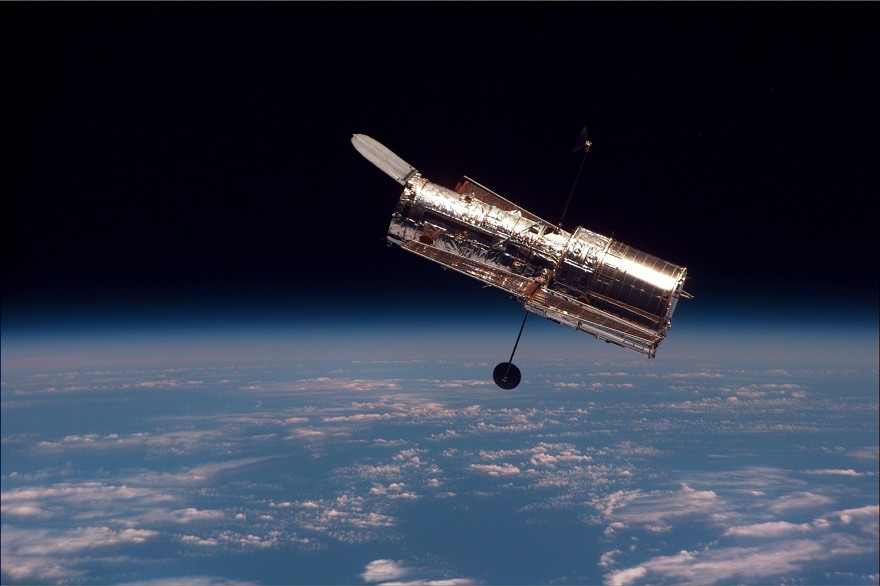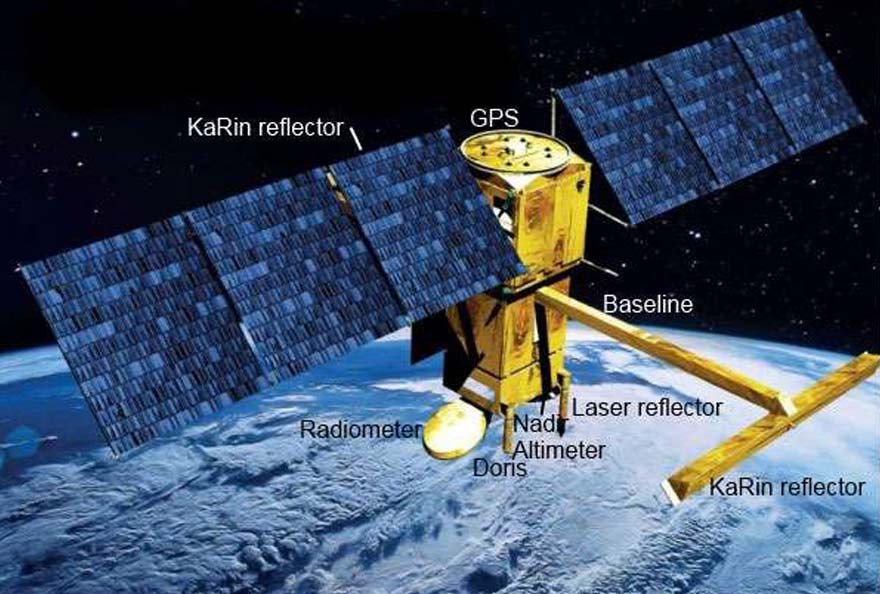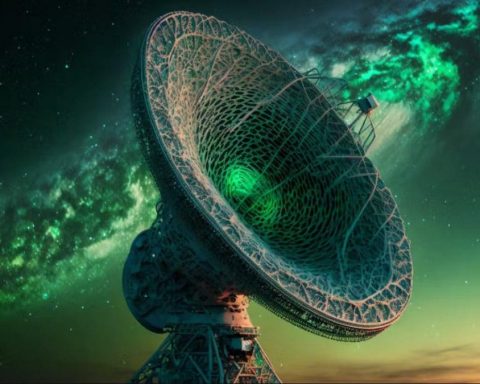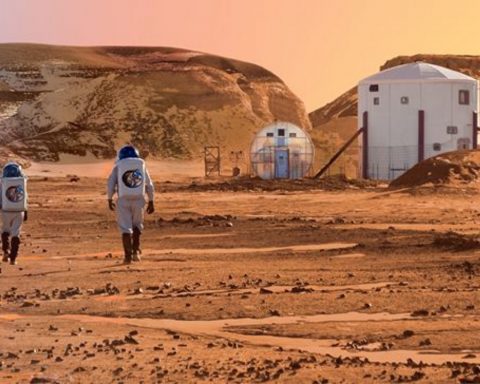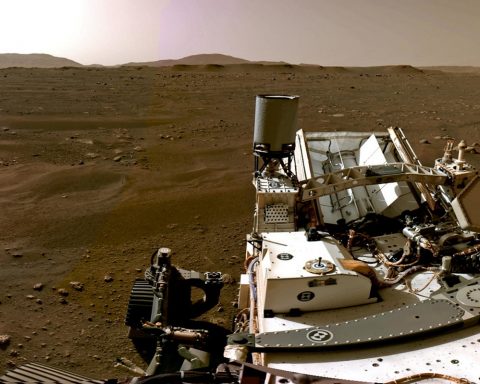
A few weeks ago, several major discoveries were made in quick succession to rekindle the hypothesis of possible extraterrestrial life. The first of these discoveries concerns Enceladus, a moon of Saturn with very special characteristics that have been confirmed by data collected by the Cassini probe (a joint project between NASA and the European - ESA - and Italian space agencies).
Photo: Hubble Enceladus Telescope
Encelade has a vast ocean under the ice on its surface and recent observations have shown steam jets emanating from the region of its South Pole. Even more interestingly, the presence of methane, a possible marker of biological activity, has been detected in these steam jets. Last month, a Franco-American study showed that the South Pole region was warmer than expected, supporting the hypothesis that the Enceladus Ocean is near the surface there, while in other regions, the ice cover is as much as 20 kilometres thick.

Cutaway view of Enceladus, moon of Saturn
If this moon, which is very far from our sun, can nevertheless produce enough heat to keep water in a liquid state, it is thanks to the tidal force resulting from the attraction that Saturn causes inside Enceladus. Even more disturbing, another study conducted by J. Hunter Waite, from the Southwest Research Institute (USA) has just analysed data collected by Cassini in 2015, when it passed near Enceladus in October 2015 (See Science). The sensors of this probe detected hydrogen gas that could come from chemical reactions between rocks on the ocean floor and water. This is a similar reaction that provides energy to the ecosystems on our planet that develop around hydrothermal springs.
Furthermore, given the detected hydrogen content (1.4 %), and the combined presence of methane and carbon dioxide, it is possible that the methanogenesis process, which is at work on Earth in the deep ocean depths, may also be active in the Enceladic Ocean. Scientists now believe that methanogenesis, which allows the production of methane by micro-organisms even in the absence of sunlight, probably played an important role in the appearance of life on our planet 3.8 billion years ago. That's why NASA says, "The presence of hydrogen in the ocean of this moon could indicate that possible microbes could use it to obtain energy by combining this hydrogen with carbon dioxide dissolved in water.
"It's the first time we've identified a place with the ingredients for a habitable environment, pointed out Thomas Zurbuchen, Deputy Head of Science Missions at NASA. "These results prove that the various studies conducted by the agency bring us closer to the moment when we can answer the question of whether or not we are alone in the Universe."he said.
As we know it, the appearance of life requires three main elements: liquid water, a source of energy for the metabolism of organisms, and chemical ingredients such as carbon, hydrogen, nitrogen, oxygen, phosphorus and sulphur, the scientists said. The data collected by Cassini show that Enceladus has almost all the ingredients necessary for habitability.
Another study also published a few weeks ago reveals that thanks to the American Hubble Space Telescope, scientists have observed in 2016 what appears to be a geyser about 100 kilometres high on Europa, one of Jupiter's largest moons, which also has an ocean under a layer of ice.
With a diameter of 3,100 km, Europe is much larger than Enceladus but has a lot in common with it. Like Enceladus, Europe has a vast ocean of liquid water beneath its icy surface. Another very interesting indication is that scientists have also detected steam jets on Europa that most probably come from hydrothermal activity. NASA now wants to go further in its research and is preparing the Europa Clipper mission, planned for the 2020s. The idea is to put a probe into orbit around Europe to collect as much data as possible on the composition of its atmosphere. In the longer term, probably by 2030, NASA is already planning a second mission, which would consist of landing a small robotic craft on Europe and trying to take samples of its surface...
Another recent discovery concerns a super-Earth orbiting a faint star that may harbour life only 40 light years away. This planet, named LHS 1140b, is about 5 billion years old; it is about 6.5 times more massive than the Earth, with a diameter 1.4 times larger and a mass seven times greater. Its density therefore tells us that it is a rocky planet, like the Earth.
LHS 1140b circles its star, a red dwarf, in 25 days and orbits right in the middle of its so-called "habitable" zone, which means that it receives the right amount of light and heat so that liquid water can be found on its surface. It is also known that, given its mass, LHS 1140b is probably composed of rocks with a dense iron core. The large size of this planet also raises the hope that an ocean of magma may have existed in the distant past and may have fed its atmosphere with vapour that would have gradually turned into liquid water.
Given the very favourable position of this planet and its star relative to the Earth, scientists believe that they will be able to use the Hubble Space Telescope to highlight the possible presence of an atmosphere around 1140b. "We could not have wished for a better target to undertake one of science's greatest quests: the search for evidence of life, outside the Earth."says Jason Dittmann of the Harvard-Smithsonian Center for Astrophysics in Cambridge (USA), co-author of the study.
With the excitement of discovering more and more Earth-like planets, the scientific community is looking forward to next year's launch of the James Webb Space Telescope (JWST), which will orbit one and a half million kilometres from Earth and be one hundred times more powerful than Hubble. This technological marvel will make it possible to observe these exoplanets with unparalleled precision and discover whether they have an atmosphere.
The next step will be to determine whether the atmospheres of the planets studied contain traces of the different gases that make up the "signature" of life! On our Earth, the presence of molecular oxygen, or dioxygen, (O2) is linked to the development of living organisms. But finding O2 in the atmosphere of another planet will not be sufficient proof of the existence of extraterrestrial life because this gas can also be produced by physico-chemical processes. To be virtually certain that life is present on another planet, we will therefore have to be able to detect the presence of its atmosphere of oxygen, water, carbon dioxide and methane simultaneously, which should be possible with the extremely sophisticated spectroscopy tools of this extraordinary telescope.
We have known since 2012, thanks to the remarkable analysis and sampling work carried out over six years by a scientific team including researchers from the Paris Institute of Astrophysics (IAP) and the French European Southern Observatory (ESO), that our galaxy has about 150 billion stars and at least 240 billion planets. In 2013, analysis of data from the Kepler Space Telescope has also shown that there will be about 40 billion Earth-like planets in orbit in the habitable areas of sun-like stars.
But due to a lack of sufficiently sensitive and efficient technological tools, it was not until 1995 that Michel Mayor (University of Geneva) and Didier Queloz (University of Cambridge) finally discovered, thanks to the spectrograph Élodie, the first exoplanet, named 51 Pegasi b, a gas giant similar to Jupiter and located 51 light years from the Earth. Today, 22 years later, more than 3,600 exoplanets have been discovered, some of which have characteristics compatible with the presence of life as we know it.
In recent decades, we have also learned that life, contrary to what we have long believed, is capable of surviving and developing in almost unimaginable conditions and particularly hostile environments: Extremophilic bacteria, such as Deinococcus radiodurans, capable, thanks to its extraordinary DNA self-repair mechanism, of surviving radiation doses several thousand times higher than we can tolerate, or Bacillus infernus, which can grow several kilometres underground or at the bottom of the Mariana Trench (11 km deep) in the Pacific Ocean.
It should also be noted that at the end of 2014, the analysis of the Tissint Martian meteorite, found in 2011 in the Moroccan desert by researchers from the Swiss Federal Institute of Technology in Lausanne (EPFL) showed that it contained traces of carbon whose isotopic characteristics support the hypothesis of a biological origin. According to the researchers, "these would follow the infiltration of a liquid rich in organic matter into the cracks in the rock while it was still on the Red Planet". This discovery therefore significantly strengthens the theories that there was life on the Red Planet at least at some point in its evolution.
Even more astonishing, the astronauts present in the International Space Station were surprised to note, during the cleaning of the portholes of this structure evolving at an altitude of 350 km, the presence of curious particles which, after analysis, turned out to be plankton cells, undoubtedly carried to the station by powerful updrafts, ... who had survived without problems for several months in the extreme vacuum and cold of space... In 2008, another amazing experiment also showed that "water bears, small organisms a millimetre long, could survive for ten days in the vacuum of space and radiation...".
The pugnacity of life, its extraordinary capacity to adapt and its prodigious diversity, can therefore reasonably lead us to hope that life, even if it needs a rare and very special combination of conditions to appear, could have been born and developed on other planets, among the hundreds of billions of worlds, including several tens of billions potentially habitable, that our galaxy alone has.
If, over the next few decades, we discover that, among the ever-expanding catalogue of exoplanets, one of them has the chemical "signature" specific to the presence of life, we will not only have taken a giant step forward in the scientific field, but our species will have to change the way it looks at itself forever. For if the appearance and development of life is finally relatively widespread on a cosmic scale, we will then be confronted in a much more powerful way with another dizzying question: has this extraterrestrial life, somewhere in our vast Universe, evolved into consciousness and intelligence?
René TRÉGOUËT, Honorary Senator - Founder of the Senate Foresight Group
Courtesy of the author - Article originally published in RT Flash
Login
0 Comments
Inline Feedbacks
View all comments

